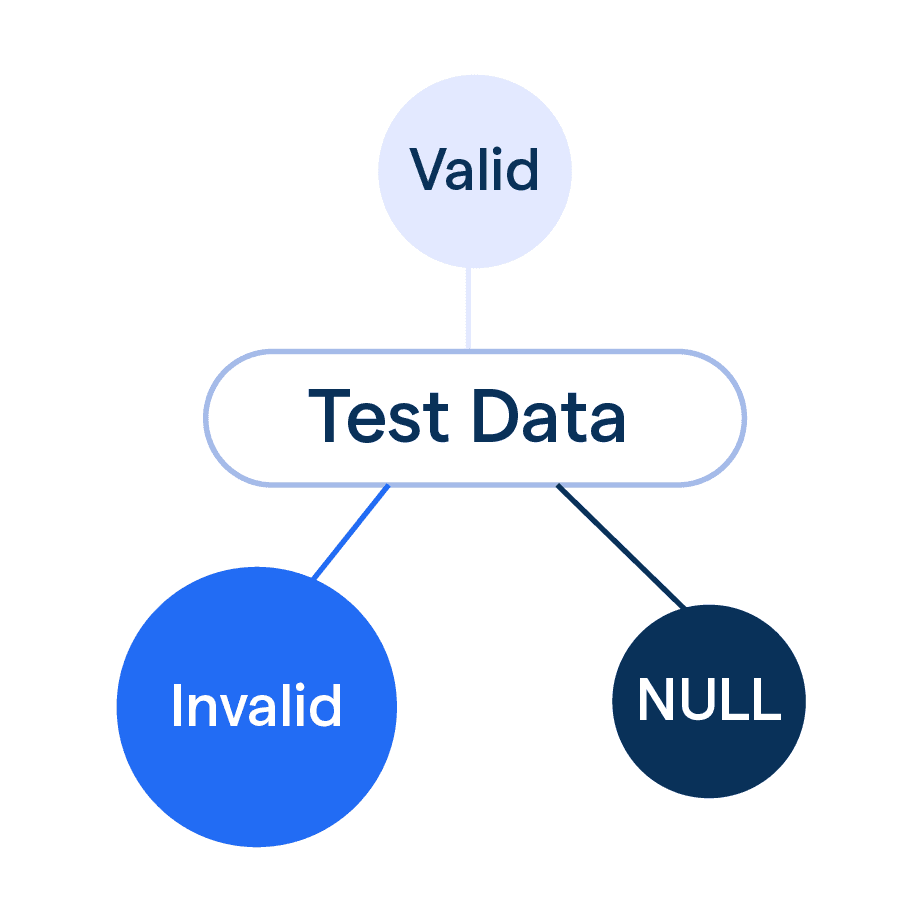What is Test Data in Software Testing?
Test Data, in the context of software testing, refers to the input values or data sets that are used to verify and validate a software application's performance, functionality, and reliability.
It may include a variety of information, ranging from user credentials, product details, files, or any other data type that the application interacts with.
Why is Test Data important in Software Testing?
Test Data is essential in software testing because it influences the depth and breadth of your application tests. It helps in identifying potential issues or bugs in the software under varying circumstances.

By testing with diverse, realistic, and relevant data, testers can evaluate how well the application handles different use scenarios, ensuring that it functions as expected in real-world conditions.
Who Uses Test Data in Software Testing?
In the software testing environment, Test Data is commonly used by QA (Quality Assurance) engineers, software testers, and developers.
These professionals use it to mimic real-life situations and validate that the software application is robust, secure, and reliable, behaving as intended under a multitude of scenarios.
When is Test Data used in Software Testing?
Test Data is employed at various stages of software testing. For example, during unit testing, a developer might use it to validate individual components of an application.
During integration testing, testers use it to ensure different software modules work correctly together.
Functional, performance, and stress testing also involve the use of test data to ensure the application behaves as expected under a wide range of conditions.
Where is Test Data used?

Test Data is utilized across the wide spectrum of software domains where testing is considered crucial for quality assurance.
From web apps, mobile apps, enterprise-level software, database systems, to AI models, and everywhere else where software performance assurance is required, test data takes front stage to reassure quality and reliability.
Types of Test Data

Now that we know the basics, let's talk about the types of test data in software testing:
- Blank data: This type of test data is used to test the program's response when no data is inputted. It helps identify if the application can gracefully handle such scenarios.
- Valid test: Ah, the beauty of valid test data! It's all about testing the program's response to inputs that meet the specified criteria.
This helps ensure that the software operates correctly with the right data.
- Invalid test: Now, here's where things get interesting! Invalid test data is used to test the program's response to inputs that do not meet the specified criteria.
Through this, we can catch any potential bugs or unexpected behavior.
- Boundary conditions: Let's push the limits, shall we? Boundary condition testing involves testing the program's response to various combinations of values that fall within the boundaries or limits defined. It helps identify if the application handles these edge cases correctly.
- Huge test: This type of test data assists in determining if the application is ready for additional types of testing, such as load and performance testing.
It allows us to assess the scalability and robustness of the software.
Benefits of Test Data
Now that we know the types, let's talk about the benefits of test data in software testing:
- Identification of coding errors and improved security: By using diverse test data, we can uncover coding errors, vulnerabilities, and security risks that might not have been detected otherwise. It's like a secret weapon against potential threats!
- Foundation for additional testing and development: Test data serves as the groundwork for conducting various types of testing, such as performance, usability, and compatibility testing. It helps us build a strong foundation for our software.
- Detection of redundancy or unnecessary duplication in code: With effective test data, we can identify redundant or unnecessary code structures.
This allows us to streamline our codebase and improve the overall efficiency of the application.
- Flexibility in managing applications across different platforms: Test data helps ensure that our software works seamlessly across different platforms and environments.
It's like a chameleon, adapting to its surroundings effortlessly.
Examples of Test Data
Now, let's bring test data to life with some examples of how it is used in software testing:
- Performance testing: Test data is crucial for measuring database speed, identifying bottlenecks, and assessing the overall performance of an application under various load conditions.
- Security testing: With the right test data, we can evaluate the effectiveness of data protection measures, uncover potential security vulnerabilities, and ensure that our software remains secure.
- Black-box testing: Test data helps us analyze the functionality of a program without having access to its internal code. It's like being a detective, trying to uncover the program's secrets!
- White-box testing: With test data, we can explore the internal structure and coding of a program. It allows us to assess code coverage, identify potential weaknesses, and ensure the application is well-structured and efficient.
How to Collect Effective Test Data
Ready for some pro tips on how to collect effective test data? Here we go:
- Importance of understanding the application and its requirements: To collect relevant test data, it's essential to have a deep understanding of the application and its requirements. It helps us identify the specific test scenarios and data needed.
- Collaborating with stakeholders to identify relevant test scenarios: Get everyone on board! Collaborating with stakeholders, including developers, business analysts, and end-users, helps identify important test scenarios and the corresponding data needed.
- Determining inputs, constraints, and boundary conditions: Careful planning is key! Determine the inputs, constraints, and boundary conditions that need to be covered during testing. It helps ensure that our test data covers all the necessary aspects.
- Using diverse data sources and generation techniques: Variety is the spice of testing! Utilize different data sources, such as databases, spreadsheets, or even external APIs, to collect diverse test data.
Also, employ various generation techniques, such as random, sequential, or boundary-based, to ensure a comprehensive dataset.
- Ensuring data quality and relevance to mimic real-world scenarios: Real-world scenarios, baby! Ensure that the test data reflects the diversity and quality of the data that the application will encounter in the real world. The closer we get to reality, the better the testing.
Common Challenges and Solutions in Test Data Management
Here, we'll discuss the common challenges faced in test data management and their feasible solutions.
Inconsistency in Test Data
- Challenge: Test data inconsistency can lead to issues in application performance and unreliable test results.
- Solution: Regularly review and monitor data quality metrics to ensure consistency. Use automated tools to identify and fix inconsistencies.
Data Privacy and Compliance Concerns

- Challenge: Test data often includes sensitive information. Ensuring data privacy while adhering to regulatory compliance standards can be difficult.
- Solution: Apply data masking and anonymization techniques to protect sensitive data. Implement strict access controls and regularly audit test data usage to comply with regulations.
Maintenance of Test Data
- Challenge: Maintaining, updating, and archiving test data for long-term use and traceability can be challenging.
- Solution: Implement lifecycle management strategies for test data, including planned data refreshes, archiving, and purging.
Using automated test data management tools can help streamline these processes.
Adequate Test Coverage
- Challenge: Ensuring comprehensive test coverage with the right set of test data can be difficult.
- Solution: Use test data generation tools to create diverse, realistic data sets that align with testing requirements.
Define data parameters to mirror real-world scenarios, enhancing test coverage.
Data Access and Distribution
- Challenge: Test teams often need access to the same data sets, and managing the distribution and availability of test data can be complex.
- Solution: Opt for a centralized test data repository that provides controlled, concurrent access to test data. Implement version control to manage changes to test data.
Scalability
- Challenge: As testing requirements expand, managing a growing volume of test data can be challenging.
- Solution: Adopt a scalable test data management strategy, leveraging cloud-based storage solutions and automating data provisioning processes to handle large volumes of test data.
Lack of Realism in Test Data
- Challenge: Test data might not accurately represent real-world conditions, leading to inadequate testing.
- Solution: Incorporate synthetic data generation techniques to create realistic test data. Use production data profiling to guide the creation of synthetic data that closely mimics real user data.
Test Data Best Practices
In this section, we'll discuss some of the best practices for handling test data in software testing.
Define Test Data Before Test Cases
One of the top best practices is to define and create test data even before you start to design your test cases.
Identifying the data you need early on can speed up the testing process significantly and can help you design more effective test cases.
Always Anonymize Sensitive Data
When using production data as test data, ensure that all sensitive information, such as personal and financial data, is anonymized or obfuscated to avoid any unauthorized access and to comply with privacy laws.
Create a Test Data Management Strategy
Having a proper test data management strategy is crucial. This can include techniques to generate, validate, and refresh test data.
It also involves setting up a secure test data environment and disposing of old data securely when no longer required.
Store Test Data Properly
Using a centralized data repository or a test data management tool for organizing, managing, and accessing test data can significantly smoothen testing process.
Maintaining an inventory of test data can also be beneficial as it allows test data to be reused, reducing the effort needed to generate new test data for each test.
Review and Update Test Data Regularly
Finally, just as test cases need to be reviewed and updated, so should test data. Regularly updating test data according to changes in the application or system under test helps in maintaining the effectiveness of the tests.
Remember, test data is just as important as your test cases. Proper care and handling of your test data can make your software testing process more efficient and reliable.
Frequently Asked Questions (FAQs)
What is test data?
Test data refers to the sample data or input values used to validate the functionality, performance, and reliability of software applications during testing.
It includes a variety of scenarios, input combinations, and edge cases designed to assess different aspects of the software's behavior and ensure its quality.
How is test data used in software testing?
Test data is used to verify the functionality, performance, and reliability of software. It helps identify bugs, assess security, and ensure the application meets requirements.
What are the different types of test data?
The different types of test data include blank data, valid/invalid data, boundary conditions, and huge data. Each type serves a specific purpose in testing.
How can I collect effective test data?
To collect effective test data, you need to understand the application requirements, collaborate with stakeholders, determine inputs/boundary conditions, and utilize diverse data sources and generation techniques.
What are the benefits of using test data in software testing?
Using test data helps identify errors, improve security, create a foundation for additional testing, detect redundant code, and ensure flexibility across different platforms and environments.
What are the common challenges in test data management?
Common challenges include data availability/confidentiality, data volume/diversity, data synchronization/updates, test environment setup/maintenance, and automation/tool compatibility.
Solutions include proper planning, documentation, and implementing data governance measures.

